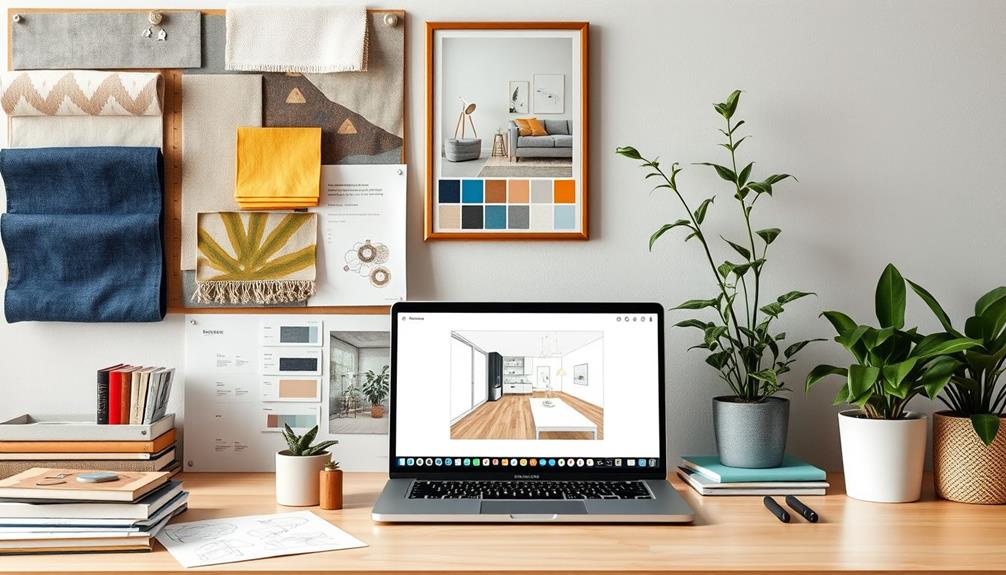To prepare for your interior design consultation, start by clearing out clutter and ensuring all decision-makers can attend. Gather inspiration photos, mood boards, and any existing plans to help convey your style. Measure your space and take notes on its dimensions. Set a realistic budget by researching costs and determining priorities. Be ready to discuss your functional needs and lifestyle preferences openly. Arriving 10 minutes early will set a positive tone. With these preparations, you'll lay the groundwork for a fruitful collaboration, uncovering more tips for a successful meeting ahead.
Key Takeaways
- Research your designer's portfolio, client testimonials, and social media presence to ensure alignment with your design vision and expectations.
- Prepare your space by decluttering and gathering inspiration photos or mood boards that reflect your desired style and preferences.
- Set a realistic budget by assessing your financial capacity and researching average costs for materials and labor, allocating for unexpected expenses.
- Ensure all key decision-makers attend the consultation to gather diverse input and align on project goals and expectations.
- Bring essential tools, such as measuring tape and photographs of the current space, to facilitate productive discussions during the consultation.
Importance of Initial Consultation

During your initial consultation, you lay the groundwork for a successful partnership with your interior designer. This meeting is vital as it establishes the designer-client relationship, fostering trust and connection.
You'll discuss your project goals and expectations, guaranteeing you and the designer are on the same page regarding the scope of work. Conducting an initial walkthrough of your space allows you both to identify specific design challenges and functional needs. This step is fundamental for effective planning and helps the designer tailor their approach to your unique requirements.
It's also the perfect time to set a realistic budget and timeline, aligning expectations and making certain your project stays within financial constraints. Open communication about your personal habits and lifestyle preferences during these initial design consultations is key.
When the designer understands your daily routines, they can create a space that truly meets your needs. Remember, a clear understanding of your vision will help your designer deliver results that reflect your style. The more you engage in this initial consultation, the better the outcome will be—after all, you want to guarantee that your client is a good fit for the designer's expertise.
Goals for the Meeting

Establishing clear goals for your initial consultation helps guarantee the meeting is productive and focused.
By outlining what you want to achieve, you can verify that both you and your designer are on the same page.
Reflect on incorporating elements from your preferred style, such as Mid-Century Modern Design, to enhance your vision.
Here are four key goals to reflect on for your first meeting:
1. Clarify the Scope of the Project: Discuss what areas you want to renovate or design, confirming all decision-makers are involved in the conversation.
2. Establish a Realistic Budget and Timeline: Be open about your financial constraints and desired timelines.
Designers typically provide estimates based on average costs, so it's essential to align expectations from the start.
3. Understand Functional Needs: Share how you currently use your space and any specific requirements you have.
This insight will help the designer propose solutions that enhance your daily living.
4. Foster Open Communication: Build a personal connection with your designer.
This encourages candid discussions about your expectations and concerns, confirming you find a good fit for the collaboration ahead.
With these goals in mind, you'll set a solid foundation for a successful initial design consultation.
Researching Your Designer

Before your consultation, it's essential to research your designer thoroughly.
Check their portfolio to see if their style matches your vision, and take a look at their social media to stay updated on their latest projects.
Additionally, read reviews and articles about them to understand their reputation and expertise in the field.
Designer Background Check
Researching your designer is an essential step in ensuring a successful interior design consultation. By taking the time to thoroughly check their background, you can align your vision with their expertise.
Here are four key areas to focus on:
- Online Presence: Conduct a Google search to review their portfolio, client testimonials, and any media coverage. This can help you gauge their style and expertise.
- Social Media: Check platforms like Instagram and Pinterest for recent projects. This will give you a real-time look at their design aesthetics and how they engage with clients.
- Professional Affiliations: Look for memberships in organizations like the American Society of Interior Designers (ASID). Such affiliations indicate a commitment to industry standards and ongoing education.
- Client Reviews: Read feedback on sites like Houzz and Yelp. This can provide insights into client satisfaction, professionalism, and communication skills.
Portfolio Evaluation
After ensuring your designer's credentials align with your needs, the next step is to evaluate their portfolio. A thorough portfolio evaluation involves reviewing the designer's portfolio available on their website and social media.
Look for a diverse range of completed projects that showcase various styles and budgets. This diversity can indicate their versatility and ability to cater to different client preferences.
Pay attention to the quality of the images in the portfolio. High-resolution photos that highlight detailed craftsmanship often reflect a designer's commitment to quality work.
Additionally, check for any awards, certifications, or recognitions listed alongside their portfolio; these can be strong indicators of their professionalism and expertise in the field.
Don't forget to seek out client testimonials. These insights provide valuable information about past clients' experiences, covering aspects like communication, project management, and overall satisfaction with the final results.
If possible, reach out directly to past clients to gain firsthand accounts of their experiences. This step will help you make an informed decision about whether the designer's style and approach align with your vision for your space.
Social Media Presence
Exploring your designer's social media presence can offer valuable insights into their style and approach. Platforms like Instagram and Pinterest are great for viewing their portfolio and evaluating if it aligns with your vision.
Here are four key aspects to focus on:
- Portfolio Showcase: Look for posts featuring completed projects. This will give you insight into the designer's creativity and attention to detail.
- Client Testimonials: Check for reviews and testimonials. Positive feedback from previous clients can indicate satisfaction and reliability.
- Engagement Level: Consider how the designer interacts with their audience. Engaging with their content by asking questions or leaving comments can help you gauge their responsiveness and communication style.
- Follower Count: A strong follower count and high engagement rate can reflect the designer's credibility and popularity in the industry.
Preparing Your Space

Preparing your space for an interior design consultation can greatly enhance the experience and outcome. Start by clearing out unnecessary items and clutter. This provides a clean slate for the designer, allowing for a better assessment of your space's potential. Verify all key decision-makers are present during the initial meeting to facilitate open communication about design preferences. Be prepared to discuss your budget and timeline with the designer so they can create a plan that aligns with your needs. Additionally, it can be helpful to gather inspiration or ideas to share with the designer, whether that be through Pinterest boards, magazine clippings, or other interior design portfolio tips. This will give the designer a better understanding of your style and preferences, ultimately leading to a more personalized and successful design process.
Next, gather inspiration photos or mood boards to visually convey your desired style. It's also essential to measure and note basic dimensions of the rooms. This gives the designer a reference for planning and verifies that furniture and layout will fit. If you have existing plans, drawings, or blueprints, make those available for review.
Here's a quick checklist to help you prepare:
| Task | Description | Status |
|---|---|---|
| Clear Clutter | Remove unnecessary items | Not Started |
| Gather Inspiration | Collect photos and mood boards | Not Started |
| Measure Space | Note dimensions of rooms | Not Started |
| Prepare Key Documents | Have plans or blueprints ready | Not Started |
| Confirm Attendees | Verify decision-makers are present | Not Started |
Setting a Budget

Setting a budget for your interior design project is essential to secure a smooth process and satisfying results. To effectively set a budget, consider the following key steps:
1. Establish a clear estimate: Determine your desired furniture, decor, and overall project goals. Remember, average spending on renovations and furnishings is around $200,000.
In the context of farmhouse aesthetics, you might want to incorporate elements like modern farmhouse decor trends to create a cohesive look that aligns with your vision.
2. Communicate constraints: Share any budget limits with your designer during the consultation. This guarantees that the proposed solutions align with your financial expectations and helps avoid surprises.
3. Research costs: Familiarize yourself with typical renovation expenses, averaging about $7,500 per room. This knowledge will equip you to make informed decisions throughout the design process.
4. Prioritize your needs: Prepare a list of must-have versus nice-to-have items. This will help you allocate your budget wisely and secure you focus on what truly matters for your initial interior design vision.
Additionally, consider setting aside a contingency fund of 10-20% of your total budget. This will help cover unexpected expenses that might arise, securing you stay on track financially.
Timing and Scheduling

Once you've established your budget, the next step is to focus on timing and scheduling for your interior design consultation. Choose a time when all key decision-makers can attend. This guarantees everyone's input is heard and minimizes misunderstandings later on.
When scheduling, consider travel time and peak hour traffic. Arriving on time shows professionalism and respect for your designer's time. Aim to select a time when distractions are minimal, so you can concentrate fully on the conversation.
It's also wise to arrive about 10 minutes early. This gives you a moment to settle in and set a positive tone for your meeting.
Set clear expectations regarding the consultation's duration, typically lasting between 1 to 2 hours. This helps both you and your designer manage time effectively and cover all necessary topics without feeling rushed.
What to Bring

When you head to your interior design consultation, it's essential to bring the right materials.
Gather inspiration photos and mood boards that showcase your style, along with measurements and a budget range for your project.
This preparation will help your designer understand your vision and create a plan that fits your needs.
Essential Tools and Materials
Preparing for your interior design consultation involves gathering essential tools and materials that will enhance the experience and guarantee a productive discussion.
By coming prepared, you can streamline the design process and ascertain that all relevant aspects are covered. Here are four key items you should bring:
- Measuring Tape: Use this to document key dimensions of your space, which helps your designer understand the layout and scale during the meeting.
- Notebook: Jot down notes about your space, any specific ideas, and insights shared during the consultation to refer back to later.
- Inspiration Photos or Mood Boards: These visuals reflect your desired style and aesthetic preferences, guiding the designer to capture your vision effectively.
- Preliminary Budget Estimate: Having an estimate based on expected renovation costs will facilitate discussions about feasible design options that fit within your financial parameters.
Design Inspiration Examples
Gathering design inspiration is key to making your interior design consultation more effective. Start by bringing a collection of inspiration photos from platforms like Pinterest and Houzz. These design inspiration examples will help you visually communicate your desired style and aesthetic preferences to your designer.
Additionally, gather magazine clippings that resonate with your personal taste, providing tangible examples of design elements you admire.
Creating a mood board can also be incredibly beneficial. Include color palettes, textures, and materials that inspire you, which will help your designer understand your vision more clearly.
Don't forget to collect photographs of your current space to offer context about existing layouts and features you want to retain or change.
Budget and Project Details
To guarantee a productive interior design consultation, it's essential to have your budget and project details organized beforehand. This preparation helps your designer provide tailored suggestions that align with your financial parameters and project scope.
Here's what you should bring:
- Budget Estimate: Prepare a rough budget based on the furniture and decor you desire. This helps the designer align their ideas with what you can realistically afford.
- Existing Drawings or Plans: Bring any sketches or floor plans of your space. These visuals facilitate clearer communication about your project's needs and dimensions.
- Photographs of the Space: Collect pictures of the areas you want to redesign. This gives the designer a better understanding of your style and functionality requirements.
- Inspiration Photos or Mood Boards: Compile images that reflect your aesthetic preferences. Sharing these can guide the designer in creating a space that resonates with your vision.
Additionally, consider your ideal timeline for project completion. Discussing this during the consultation will help the designer manage expectations effectively.
Conclusion
As you commence this creative journey, remember that your consultation is the first brushstroke on a blank canvas. By coming prepared, you're not just sharing your vision; you're igniting a collaborative spark that can transform your space into a sanctuary. Embrace the process, stay open-minded, and let your designer's expertise guide you. With a clear plan and a touch of imagination, you'll soon watch your dream interior blossom into reality.







